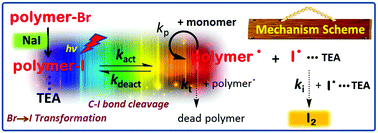Visible-light-induced living radical polymerization using in situ bromine-iodine transformation as an internal boost†
Abstract
A facile and effective visible-light-induced living radical polymerization (LRP) system was successfully developed at room temperature using typical alkyl bromides (such as ethyl α-bromophenylacetate (EBPA) and 2-bromopropanenitrile (BPN)) as the initiator in the presence of sodium iodide (NaI) for the first time. Water-soluble poly(ethylene glycol) methyl ether methacrylate (PEGMA) was used as the model monomer. By investigating the influencing factors including initiator and solvent type, solvent volume, light source, activator (sodium iodide) and catalyst (triethylamine) concentration, and degree of polymerization (DP), optimized polymerization conditions could be established. Excellent control over molecular weights and distributions (Mw/Mn = 1.05–1.33) of the polymers was achieved under light-emitting diode (LED) irradiation. In addition, the moderate polymerization rate could be drastically promoted in the presence of triethylamine (TEA) as the catalyst. This polymerization system exhibited instantaneous control in response to the on–off switch of the irradiation stimulus. Various types of other monomers (such as methyl methacrylate (MMA) and glycidyl methacrylate (GMA)) and illumination sources (especially sunlight) also proved to be compatible with this LRP system. The possible polymerization mechanism was investigated, and the bromine-iodine transformation activated LRP in this study will enable the facile preparation of well-defined materials with satisfactory controllability and versatile architectures.



 Please wait while we load your content...
Please wait while we load your content...